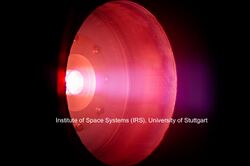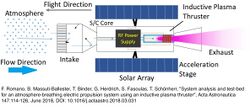Engineering:Atmosphere-breathing electric propulsion
Atmosphere-breathing electric propulsion, or air-breathing electric propulsion, shortly ABEP,[1] is a propulsion technology for spacecraft, which could allow thrust generation in low orbits without the need of on-board propellant, by using residual gases in the atmosphere as propellant. Atmosphere-breathing electric propulsion could make a new class of long-lived, low-orbiting missions feasible.
The concept is currently being investigated by the European Space Agency (ESA) [2] and the EU-funded DISCOVERER project.[3] Current state-of-the-art conventional electric thrusters cannot maintain flight at low altitudes for any times longer than about 2 years,[4] because of the limitation in propellant storage and in the amount of thrust generated, which force the spacecraft's orbit to decay. The ESA officially announced the first successful RAM-EP prototype on-ground demonstration in March 2018.[5]
Principle of operation
An ABEP is composed by an intake and an electric thruster: rarefied gases which are responsible for drag in low Earth orbit (LEO) and very low Earth orbit (VLEO), are used as the propellant.[6][7] This technology would ideally allow S/Cs to orbit at very low altitudes (< 400 km around the Earth) without the need of on-board propellant, allowing longer time missions in a new section of atmosphere's altitudes. This advantage makes the technology of interest for scientific missions, military and civil surveillance services as well as low orbit even lower latecy communication services than Starlink.
A special intake will be used to collect the gas molecules and direct them to the thruster. The molecules will then be ionized by the thruster and expelled from the acceleration stage at a very high velocity, generating thrust. The electric power needed can be provided by the same power subsystems developed for the actual electric propulsion systems, likely a combination of solar arrays and batteries, though other kind of electric power subsystems can be considered. An ABEP could extend the lifetime of satellites in LEO and VLEO by compensating the atmospheric drag during their time of operation. The altitude for an Earth-orbiting ABEP can be optimised between 120-250 km.[8] This technology could also be utilized on any planet with atmosphere, if the thruster can process other propellants, and if the power source can provide the required power, e.g. sufficient solar irradiation for the solar panels, such as Mars and Venus, otherwise other electric power subsystems such as a space nuclear reactor or radioisotope thermoelectric generator (RTG) have to be implemented, for example for a mission around Titan.
Concepts and testing

In the development of atmosphere-breathing ion engines, a notable extension of Child's Law led to the first publication of the ABEP concept in 1995.[9][10] Originally, Child's Law modeled the flow of charge between an anode and a cathode with the assumption that the initial velocity of ions was zero. This assumption, however, is not applicable to ion engines operating in low Earth orbit, where ambient gas enters the ionization chamber at high velocities.
Buford Ray Conley provided a generalization of Child's Law that accounts for a non-zero initial velocity of ions. This adaptation has been significant for the theoretical modeling of ion propulsion systems, particularly those that operate in the rarefied conditions of low Earth orbit.
Impact on Atmosphere-Breathing Ion Engines
The generalization of Child's Law has implications for the design and efficiency of atmosphere-breathing ion engines. By accounting for the high-velocity ambient gas that enters the ionization chamber in low Earth orbit, the modified law allows for more accurate theoretical modeling. Once the ambient gas is ionized in the chamber, it is electromagnetically accelerated out of the exhaust, contributing to the propulsion of the spacecraft.
ESA's RAM-EP, designed and developed by SITAEL in Italy, was first tested in laboratory in May 2017.[11][12][13]
The Institute of Space Systems at the University of Stuttgart is developing the intake and the thruster, the latter is the RF helicon-based Plasma Thruster (IPT) [14],[15] which has been ignited for the first time in March 2020, see IRS Uni Stuttgart Press Release. Such a device has the main advantage of no components in direct contact with the plasma, this minimizes the performance degradation over time due to erosion from aggressive propellants, such as atomic oxygen in VLEO, and does not require a neutralizer. Intake and thruster are developed within the DISCOVERER EU H2020 Project.
Intakes have been designed in multiple studies, and are based on free molecular flow condition and on gas-surface interaction models: based on specular reflections properties of the intake materials, high efficiencies can theoretically be achieved by using telescope-like designs. With fully diffuse reflection properties, efficiencies are generally lower, but with a trapping mechanism the pressure distribution in front of the thruster can be enhanced as well.[16]
Busek Co. Inc. in the U.S. patented their concept of an Air Breathing Hall Effect Thruster (ABHET) in 2004,[17] and with funding from the NASA Institute for Advanced Concepts, started in 2011 a feasibility study that would be applied to Mars (Mars-ABHET or MABHET), where the system would breath and ionize atmospheric carbon dioxide.[18] The MABHET concept is based on the same general principles as JAXA's Air Breathing Ion Engine (ABIE) or ESA's RAM-EP.[19]
See also
- Ion-propelled aircraft
- Astronomy:Propulsive fluid accumulator – A self-filling orbital rocket fuel depot
References
- ↑ Romano, Francesco (January 2022). RF Helicon Plasma Thruster for an Atmosphere-Breathing Electric Propulsion System (ABEP). Verlag Dr. Hut. p. 165. ISBN 978-3-8439-4953-8. https://www.dr.hut-verlag.de/978-3-8439-4953-8.html.
- ↑ "World-first firing of air-breathing electric thruster". Space Engineering & Technology (European Space gency). 5 March 2018. http://www.esa.int/Our_Activities/Space_Engineering_Technology/World-first_firing_of_air-breathing_electric_thruster.
- ↑ "Home - Discoverer". https://discoverer.space/.
- ↑ D. DiCara, J. G. del Amo, A. Santovincenzo, B. C. Dominguez, M. Arcioni, A. Caldwell, and I. Roma, "RAM electric propulsion for low earth orbit operation: an ESA study", 30th IEPC, IEPC-2007-162, 2007
- ↑ "World-first firing of air-breathing electric thruster". Space Engineering & Technology (European Space Agency). 5 March 2018. http://www.esa.int/Our_Activities/Space_Engineering_Technology/World-first_firing_of_air-breathing_electric_thruster.
- ↑ T. Schönherr, K. Komurasaki, F. Romano, B. Massuti-Ballester, and G. Herdrich, Analysis of Atmosphere-Breathing Electric Propulsion, IEEE Transactions on Plasma Science, vol.43, no.1, January 2015
- ↑ Romano, Francesco; Massuti-Ballester, Bartomeu; Binder, Tilman; Herdrich, Georg; Schönherr, Tony (2018). "System analysis and test-bed for an atmosphere-breathing electric propulsion system using an inductive plasma thruster". Acta Astronautica 147: 114–126. doi:10.1016/j.actaastro.2018.03.031. Bibcode: 2018AcAau.147..114R. https://zenodo.org/record/3505986.
- ↑ Romano, Francesco; Massuti-Ballester, Bartomeu; Binder, Tilman; Herdrich, Georg; Schönherr, Tony (2018). "System analysis and test-bed for an atmosphere-breathing electric propulsion system using an inductive plasma thruster". Acta Astronautica 147: 114–126. doi:10.1016/j.actaastro.2018.03.031. Bibcode: 2018AcAau.147..114R. https://zenodo.org/record/3505986.
- ↑ "Space charge" (in en), Wikipedia, 2023-09-11, https://en.wikipedia.org/w/index.php?title=Space_charge&oldid=1174948009, retrieved 2023-10-27
- ↑ Conley, Buford Ray (May 1995). "Utilization of Ambient Gas as a Propellant for Low Earth Orbit Electric Propulsion" (PDF). Masters Thesis, Massachusetts Institute of Technology, Cambridge, MA: Page 24, equation 3.43 – via https://dspace.mit.edu/bitstream/handle/1721.1/31061/33887503-MIT.pdf?sequence=2
- ↑ "Development and Experimental Validation of a Hall Effect Thruster RAM-EP Concept". 2017. http://electricrocket.org/IEPC/IEPC_2017_377.pdf.
- ↑ World-first firing of air-breathing electric thruster ESA 5 March 2018
- ↑ "SITAEL space team successfully announces world premiere RAM-EP laboratory demonstration". SITAEL. 27 May 2017. https://www.sitael.com/sitael-space-has-successfully-tested-ram-ep-system/.
- ↑ Romano, Francesco (January 2022). RF Helicon Plasma Thruster for an Atmosphere-Breathing Electric Propulsion System (ABEP). Verlag Dr. Hut. p. 165. ISBN 978-3-8439-4953-8. https://www.dr.hut-verlag.de/978-3-8439-4953-8.html.
- ↑ Romano, Francesco; Chan, Yung-An; Herdrich, Georg (2020). "RF Helicon-based Inductive Plasma Thruster (IPT) Design for an Atmosphere-Breathing Electric Propulsion system (ABEP)". Acta Astronautica 176: 476–483. doi:10.1016/j.actaastro.2020.07.008. Bibcode: 2020AcAau.176..476R. https://www.sciencedirect.com/science/article/abs/pii/S0094576520304264.
- ↑ Romano, Francesco; Espinosa-Orozco, Jesus; Pfeiffer, Marcel; Herdrich, Georg (2021). "Intake design for an Atmosphere-Breathing Electric Propulsion System (ABEP)". Acta Astronautica 187: 225–235. doi:10.1016/j.actaastro.2021.06.033. Bibcode: 2021AcAau.187..225R. https://www.sciencedirect.com/science/article/pii/S0094576521003301. Retrieved 19 May 2022.
- ↑ V. Hruby; B. Pote. "Air breathing electrically powered Hall effect thruster". Busek Company, Inc., Natick, Maine, USA, Patent US 6,834,492 B2, December 2004. https://patents.google.com/patent/US6834492.
- ↑ K. Hohman. "Atmospheric Breathing Electric Thruster for Planetary Exploration". NIAC Spring Symposium, March 27–29, 2012. https://www.nasa.gov/pdf/636899main_Hohman_Presentation.pdf.
- ↑ ABEP (Air-breathing Electric Propulsion) development for future low-orbit space flight eoPortal ESA
 |
- ↑ Anmol Taploo, Li Lin, Michael Keidar; Analysis of ionization in air-breathing plasma thruster. Physics of Plasmas 1 September 2021; 28 (9): 093505. https://doi.org/10.1063/5.0059896
- ↑ Taploo, A., Lin, L. & Keidar, M. Air ionization in self-neutralizing air-breathing plasma thruster. J Electr Propuls 1, 25 (2022). https://doi.org/10.1007/s44205-022-00022-x
- ↑ Taploo, A., Soni, V., Solomon, H. et al. Characterization of a circular arc electron source for a self-neutralizing air-breathing plasma thruster. J Electr Propuls 2, 21 (2023). https://doi.org/10.1007/s44205-023-00058-7


